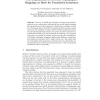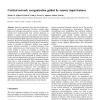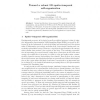5 search results - page 1 / 1 » Self-organized cortical map formation by guiding connections |
ICANN
2010
Springer
13 years 6 months ago
2010
Springer
One way to handle the perception of images that change in position (or size, orientation or deformation) is to invoke rapidly changing fiber projections to project images into a fi...
ISCAS
2005
IEEE
13 years 10 months ago
2005
IEEE
We describe an algorithm for self-organizing connections from a source array to a target array of neurons that is inspired by neural growth cone guidance. Each source neuron proje...
AUSAI
2006
Springer
13 years 6 months ago
2006
Springer
Abstract. It is known from psychology and neuroscience that multimodal integration of sensory information enhances the perception of stimuli that are corrupted in one or more modal...
BC
2002
13 years 4 months ago
2002
Abstract. Sensory experience alters the functional organization of cortical networks. Previous studies using behavioral training motivated by aversive or rewarding stimuli have dem...
ESANN
2007
13 years 6 months ago
2007
Abstract. Several models have been proposed for spatio-temporal selforganization, among which the TOM model by Wiemer [1] is particularly promising. In this paper, we propose to ad...



